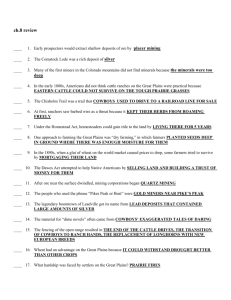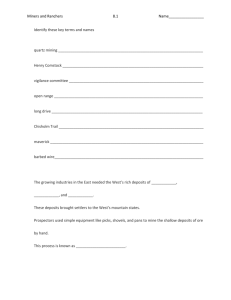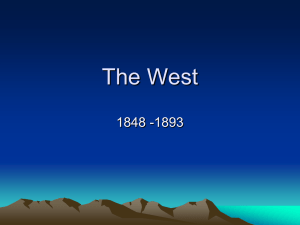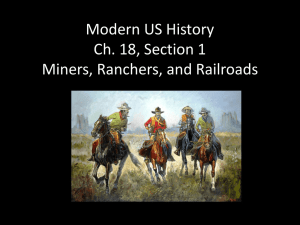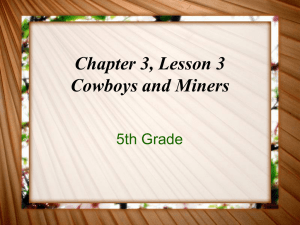File
advertisement
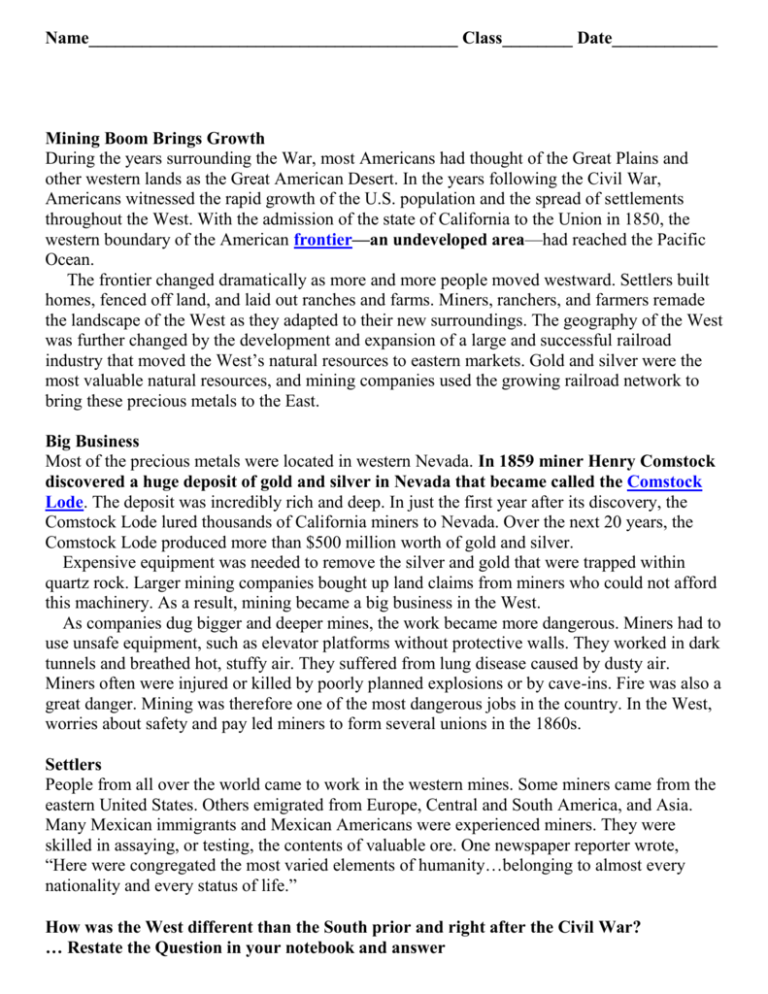
Name__________________________________________ Class________ Date____________ Mining Boom Brings Growth During the years surrounding the War, most Americans had thought of the Great Plains and other western lands as the Great American Desert. In the years following the Civil War, Americans witnessed the rapid growth of the U.S. population and the spread of settlements throughout the West. With the admission of the state of California to the Union in 1850, the western boundary of the American frontier—an undeveloped area—had reached the Pacific Ocean. The frontier changed dramatically as more and more people moved westward. Settlers built homes, fenced off land, and laid out ranches and farms. Miners, ranchers, and farmers remade the landscape of the West as they adapted to their new surroundings. The geography of the West was further changed by the development and expansion of a large and successful railroad industry that moved the West’s natural resources to eastern markets. Gold and silver were the most valuable natural resources, and mining companies used the growing railroad network to bring these precious metals to the East. Big Business Most of the precious metals were located in western Nevada. In 1859 miner Henry Comstock discovered a huge deposit of gold and silver in Nevada that became called the Comstock Lode. The deposit was incredibly rich and deep. In just the first year after its discovery, the Comstock Lode lured thousands of California miners to Nevada. Over the next 20 years, the Comstock Lode produced more than $500 million worth of gold and silver. Expensive equipment was needed to remove the silver and gold that were trapped within quartz rock. Larger mining companies bought up land claims from miners who could not afford this machinery. As a result, mining became a big business in the West. As companies dug bigger and deeper mines, the work became more dangerous. Miners had to use unsafe equipment, such as elevator platforms without protective walls. They worked in dark tunnels and breathed hot, stuffy air. They suffered from lung disease caused by dusty air. Miners often were injured or killed by poorly planned explosions or by cave-ins. Fire was also a great danger. Mining was therefore one of the most dangerous jobs in the country. In the West, worries about safety and pay led miners to form several unions in the 1860s. Settlers People from all over the world came to work in the western mines. Some miners came from the eastern United States. Others emigrated from Europe, Central and South America, and Asia. Many Mexican immigrants and Mexican Americans were experienced miners. They were skilled in assaying, or testing, the contents of valuable ore. One newspaper reporter wrote, “Here were congregated the most varied elements of humanity…belonging to almost every nationality and every status of life.” How was the West different than the South prior and right after the Civil War? … Restate the Question in your notebook and answer _____________________________________________________________________________ ___________________________________________________________________________ New Towns Mining booms also produced boomtowns, communities that grew suddenly when a mine opened. They disappeared just as quickly when the mine closed. Most boomtowns had general stores, saloons, and boardinghouses. Few women or families lived in boomtowns. “I was never so lonely and homesick in all my life,” wrote one young woman. Women washed, cooked, made clothes, and chopped wood. They also raised families, established schools, and wrote for newspapers. Their work helped turn some mining camps into successful, permanent towns. Summarizing What risks did miners face? … Restate the Question in your notebook and answer _____________________________________________________________________________ ___________________________________________________________________________ Myth and Reality in the Wild West No episode in American history has given rise to as many myths as the Wild West. Writers of dime nov created the myths in the years after the Civil War. Even today, popular books, television shows, and mo in ways that are more myth than reality. Myth: The cowboy was a free-spirited individual. Reality: Most cowboys were employees. Many joined labor unions and even went on strike. Myth: Western cowtowns were wild places where cowboys had gunfights, and there was little law and Reality: Most were orderly cities with active law enforcement. Showdowns rarely, if ever, occurred. Myth: Almost all cowboys were Anglo Americans. Reality: About 25 percent of cowboys were African Americans, and 12 percent were Hispanic. In 1867 businessman Joseph McCoy discovered a solution. He built pens for cattle in the small town of Abilene, Kansas. The Kansas Pacific Railroad line went through Abilene. As a result, cattle could be shipped by rail from there. Soon, countless Texas ranchers were making the trip north to Abilene to sell their herds of cattle. Around the same time, cattle ranching began to expand in the Midwest. The Great Plains from Texas to Canada, where many ranchers raised cattle in the late 1800s, became known as the Cattle Kingdom. Ranchers grazed huge herds on public land called the open range. The land had once been occupied by Plains Indians and buffalo herds. Importance of Cowboys The workers who took care of the ranchers’ cattle were known as cowhands or cowboys. They borrowed many techniques and tools from vaqueros (bah-KER-ohs), Mexican ranch hands who cared for cattle and horses. From vaqueros came the western saddle and the lariat—a rope used for lassoing cattle. The cowboys also borrowed the vaqueros’ broad felt hat. However, they changed it into the familiar high-peaked cowboy hat. One of the cowboy’s most important and dangerous duties was the cattle drive. On these long journeys, cowboys herded cattle to the market or to the northern Plains for grazing. The trips usually lasted several months and covered hundreds of miles. The Chisholm Trail, which ran from San Antonio, Texas, to the cattle town of Abilene, Kansas, was one of the earliest and most popular routes for cattle drives. It was blazed, or marked, by Texas cowboy Jesse Chisholm in the late 1860s. At times, rowdy cowboys made life in cattle towns rough and violent. There were rarely shoot-outs in the street, but there was often disorderly behavior. Law officials such as Wyatt Earp became famous for keeping the peace in cattle towns. End of the Open Range As the cattle business boomed, ranchers faced more competition for use of the open range. Farmers began to buy range land on the Great Plains where cattle had once grazed. Small ranchers also began competing with large ranchers for land. Then in 1874, the invention of barbed wire allowed westerners to fence off large amounts of land cheaply. The competition between farmers, large ranchers, and small ranchers increased. This competition led to range wars, or fights for access to land. Making matters worse, in 1885 and 1886, disaster struck the Cattle Kingdom. The huge cattle herds on the Plains had eaten most of the prairie grass. Unusually severe winters in both years made the ranching situation even worse. Thousands of cattle died, and many ranchers were ruined financially. The Cattle Kingdom had come to an end. Drawing Conclusions Why did the Cattle Kingdom come to an end? … Restate the Question in your notebook and answer _____________________________________________________________________________ ___________________________________________________________________________
